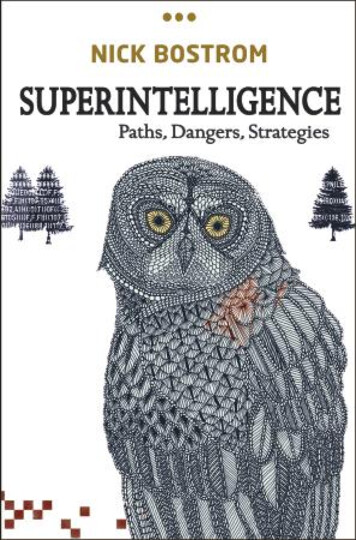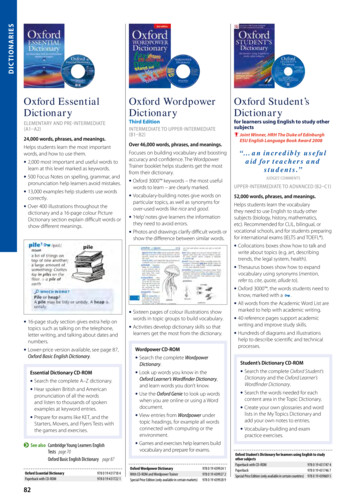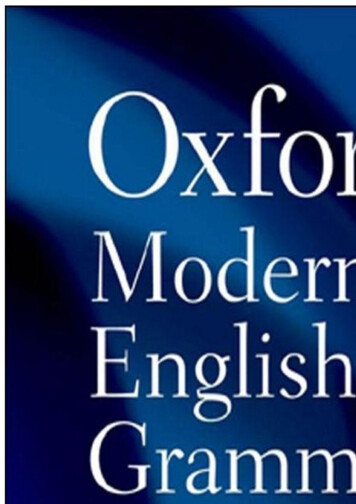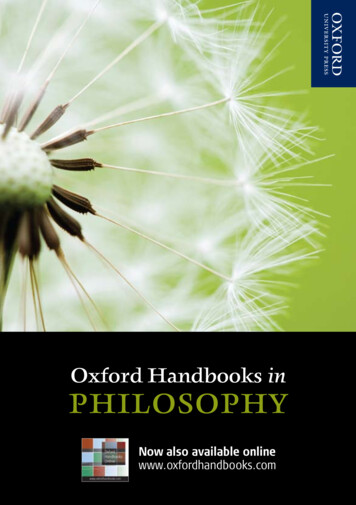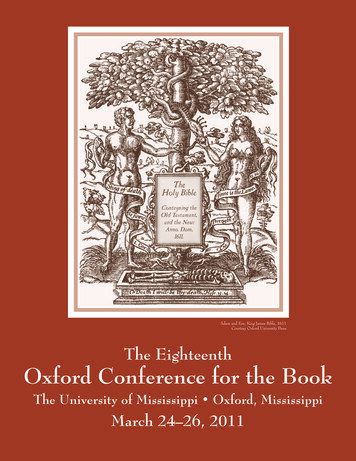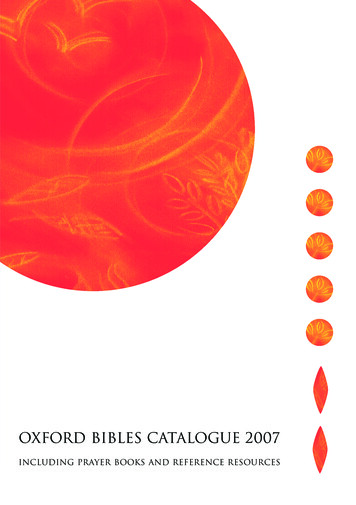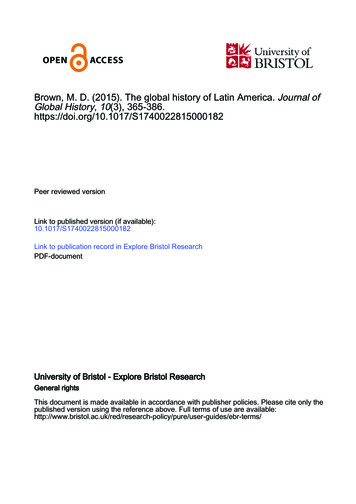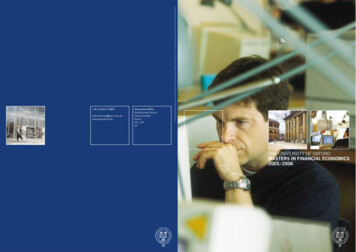Transcription
54FUYO OSAWAConference on English Historical Linguistics. University of Glasgow.Osawa, Fuyo. 2003'. "Syntactic Parallels between Ontogeny and Phylogeny." Lingua.113.1, 3-47.Osawa, Fuyo. 20036. "The Rise of IPs in the History of English." Historical Linguistics2001, ed by Blake, B. J. and K. Burridge, 319-335. Amsterdam & Philadelphia: JohnBenjamins.Osawa, Fuyo. 2003'. The Development of Complementation: from Nominalization toEmbedding, Paper presented at The 16th International Conference on Historical Linguistics, University of Copenhagen, August 2003.Radford, Andrew. 1990. Syntactic Theory and the Acquisition of English Syntax. Oxford:Blackwell.Sweet, Henry. 1953. Sweet's Anglo-Saxon Primer, revised throughout by Norman Davis.Oxford: Clarendon.Thrainsson, Hi5skuldur. 1996. "On the (Non)-Universality of Functional Categories".Minimal Ideas: Syntactic Studies in the Minimalist Framework ed. by Abraham, W. et. al.253-281. Amsterdam & Philadelphia: John Benjamins.Tsimpli, Ianthi-Maria. 1996. The Prefunctional Stage of Language Acquisition. New York:Garland.An Analysis of the Oxford Advanced Learner's Dictionary of Current English, Seventh Edition,with Special Reference to the CD-ROMYURI KOMUROSATORU UCHIDAYUKO SHITARA-MATSUO AKIHI KO KAWAMURAYASUTAKE I SHIITAKASHI KANAZASHII. IntroductionThis paper is a critical analysis of the Oxford Advanced Learner'sDictionary of Current English, seventh edition (2005) (hereafter abbreviated as OALD7) with a primary focus on its CD-ROM. The dictionary isavailable either with or without a CD-ROM named the Oxford AdvancedLearner's Compass (hereafter OALD7 -CD). Among its innovations, OALD7is the first in its 60-year tradition to mark important words with keysymbols in larger type, and the defining vocabulary (hereafter DV) ofabout 3,000 words used in the sixth edition is now called the keywords ofthe Oxford 3000. OALD7 also features 2,000 new words and has built-inaudio-recordings designed to assist users unable to read phonetic transcriptions. Altogether, OALD7-CD contains the whole of the seventhedition, the Oxford Learner's Wordfinder Dictionary and the Oxford Guideto British and American Culture, as well as information on 20,000 wordorigins, with search and audio facilities. Despite these advances, OALDhas generally been left a little behind its rivals in the availability of its CDROM version. The fifth edition (hereafter OALD5), published in 1995,first became available in CD-ROM format with some additional featuresin 1997 as the Oxford Advanced Learner's Dictionary CD-ROM Edition,and the sixth edition published in 2000 was also made available on CDROM the following year as the Oxford Advanced Learner's Dictionary
57KOMURO, UCHIDA, SHITARA-MATSUO, KAWAMURA, ISHII, KANAZASHIAn Analysis of the OALD7 with Special Reference to the CD-ROMCD-ROM New Edition (hereafter OALD6-CD). However, only "a severely cutdown version" of this CD-ROM was bundled with the printdictionary (Jackson 2002: 141). The seventh edition is thus the firstcomplete edition of the OALD with a CD-ROM comparable to those ofits competitors, such as the Macmillan English Dictionary (2002) (hereafterMED), the Longman Dictionary of Contemporary English, fourth edition(2003) (hereafter LDOCE4), the Cambridge Advanced Learner's Dictionary(2003), and the Cobuild Advanced Learner's English Dictionary, fourthedition (2003) (hereafter COBUILD4).Our analysis will cover three main aspects: lexicographical observations,inspection of functions and searchability of the CD-ROM, and user study.As for the paper version, the main A-to-Z text has been increasing overthe last revisions. The fourth edition has 1,392 pages, the fifth edition,1,508 pages, and the present edition, 1,780 pages'). In the first place, weare interested to find out how the space increased by about 18% is used inOALD7. Our preliminary survey, a sampling of every 300 pages (300—301 , 600-601, 900-901, 1200-1201, 1500-1501), identified few majorchanges between the previous and present editions, apart from newlyintroduced headwords. We will look at the OALD7 in terms of thewordlist, pronunciation, definitions, examples, and usage notes, with reference to the previous edition, OALD6, and/or to its competitors, whereappropriate. Indeed, our main areas of interest are:2. HeadwordsThis section examines the headwords in OALD7. The results of ourpreliminary survey on the sample pages (300-301 (comfortably tocommentate), 600-601 (foldaway to fool), 900-901 (live2 to loantranslation), 1200-1201 (prithee to probity) and 1500-1501 (status barto steaming)) suggest that OALD7 has more headwords than OALD6.In fact, according to the blurb, it is claimed that 2000 new words havebeen added to the present edition. In the following subsections we willconsider their coverages and treatments mainly by comparing the twoeditions. We will begin by considering the coverage of headwords, andthen move on to the presentations of headwords, idioms and phrasalverbs. While OALD6-CD occasionally contains words not listed in thepaper version (e.g. birdseed and citizen's arrest), as far as the samplepages are concerned, there are no differences between OALD7 and OALD7CD. Accordingly, for the sake of convenience, the following discussionswill be basically based on the printed editions.56( 1 ) What kinds of words have been newly added?;( 2 ) How are the recordings and transcriptions are actually arranged?;( 3 ) How is the Oxford 3000 different from the previous DV?In the second part of our analysis, we will investigate and assess the searchfunctions of the OALD7-CD and their searchability to see whether ittakes full advantage of CD-ROM medium. Finally, we will conclude ourcritique by evaluating the user-friendliness of both the paper and electronic versions of OALD7. Here, we will report on empirical research intoJapanese learners' navigational skills as well as their conventional dictionary look-up skills with the OALD7.2.1. SamplingFor the comparison between OALD6 and OALD7, all the headwordson the following 34 pages of OALD7 are compared with the corresponding headwords in OALD6: 100-101 (badass to baguette), 200-201 (burnerto bury), 300-301 (comfortably to commentate), 400-401 (defeat todefog), 500-501 (employee to encounter), 600-601 (foldaway to fool),700-701 (halogen to hand), 800-801 (injured party to inrush), 900901 (live2 to loan translation), 1,000-1,001 (moviegoer to mudslide),1,100-1,101 (parallel turn to park), 1,200-1,201 (prithee to probity),1,300-1,301 (returnable to revert), 1,400-1,401 (shepherd to Shinto),1,500-1,501 (status bar to steaming), 1,600-1,601 (threw to throw)and 1,700-1,701(vested interest to video card). Other pages will also beexamined whenever necessary.2.2. Coverage of headwordsA survey was made on the sample pages to compare the coverage of theheadwords in OALD6 with that of OALD7. The results are shown below
An Analysis of the OALD7 with Special Reference to the CD-ROMKOMURO, UCHIDA, SHITARA-MATSUO, KAWAIVIURA, ISHII, KANAZASHI58at Table 2.1; all the headwords which only appear in OALD7 are markedas [ 7, —6] and those appearing only in OALD6 as [-7, 6].The estimated number of total headwords, according to the figuresbelow, will be 40,228 (22.6 (the average number of headwords perpage) x 1780 (the total number of the text from A-to-Z). Run-ons are notincluded).Table 2.1 A comparison of the coverages of the headwords between OALD6 andOALD7pages headwords [ 7, —6] [-7, 6]pages headwords [ 7, —6] [-7, 6]100-101338 (1)01000-100155180200-201259 (1)01100-11016410 (1)0300-3014101200-12014740400-401404 (1)01300-1301486 (1)0500-50161701400-140145600-601487 -1701900-901459 (1)0per page03610923206712022.64 (0.2)00Note: Numbers in parentheses indicate run-ons.2.2.1. Newly added itemsThe blurb in the back cover claims to have 2000 new words such asbird flu, life coach, and offshoring. However, Table 2.1 would suggestthat OALD7 has introduced more than 7000 new items, a figure whichcan be obtained from the multiplication 4 (the average additions per page)by 1780 (the total number of pages). Precisely, the estimated number ofthe newly entered items is 7120. The following are some random examplesof the added items from the sample pages:badass, burnous, bursa, bursitis, bursty, comfort station, cornfrey, command language, commensal, defensive medicine,defibrillation, defining vocabulary, folk etymology, food science, food web, halloo, halwa, hammerhead, inkjet printer, inmedias res, inquorate, loading, loan translation, mozzie, MP3,MP3 player, MPEG, Mr. Clean, MRSA, mucker, Paralympics,59parastatal, parataxis, parishad, prithee, revanchism, reverb,Sherlock, sherwani, shifter, shiitake, shim, shindy, shiner,status bar, statutory holiday, steak tartare, stealth tax,steaming, thrift shop, throughway, vichyssoise, victualler, videand video cardA plausible explanation for the estrangement between the claim of theblurb and the survey on the sample pages seems to be that 'new words'used in the blurb refer only to the words which are newly entered in theEnglish lexicon. On the other hand, the figure obtained from the surveyshows the number of 'new headwords' in OALD7 including 'new words.'This means that approximately 5000 items are newly introduced in OLAD7in addition to the 'new words.' Although it is difficult to distinguish thesetwo categories, an examination of the occurrences of each new item in theBNC (the second edition of the British National Corpus) may be helpfulto determine the difference between them. Twenty new words in OALD7were randomly taken out from the sample pages and examined in theBNC with the date restriction being before 1993. The three words (birdflu, life coach and offshoring) that are shown in the back cover as newwords are also investigated for the purpose of comparison. The results areshown below:Table 2.2 The occurrences of the words of the blurb in the BNCwordsoccurrencesbird flu1life coach0offshoring0Table 2.3 The occurrences of the newly introduced items in the e medicine6halwa0commensal10MP3status bar0Paralympics0food web(s)badass1food science(s)102 (10)15 (2)
7r60KOMURO, UCHIDA, SHITARA-MATSUO, KAWAMURA, ISHII, KANAZASHIburnous1command language18shiitake2inkjet printer(s)10 (12)mozzie(s)1 (3)comfrey(s)25 (1)statutory holiday(s)3 (2)video card(s)22 (4)emulsifier(s)0 (6)reverb(s)145 (5)Notes: (1) Numbers in parentheses indicate occurrences of plural forms; (2) Thewords are arranged in order of total occurrences.An Analysis of the OALD7 with Special Reference to the CD-ROM612.2.2. VarietiesIt is not to be overlooked here that the majority of the new headwordsare given labels specifying a region where a particular headword is mainlyused: NAmE for comfort station; AustralE and NZE for loading; CanEfor statutory holiday (see Section 4.4.2.). While Akasu et al. (2001) pointout that it is one of the most remarkable features of OALD6 to treatAmerican English far more extensively than the former edition, OALD7seems to give more balanced treatment to other varieties of English. Thismight also be an attempt to help the user ready for a wider range ofAlthough it is hard to draw a precise line, it can be said at least that [ 7,reading (see Section 4.1.).—6] items contain some frequently used words in the text before 1993,which implies OALD7 has introduced not only many new words but also2.2.3. Deleted itemsmany others that are not new as English words.Regarding the words newly introduced in the seventh edition but 'notSo far as the 34 pages are concerned, no items have been removed fromOALD6. However, there are occasionally items that appear in OALD6new' as English words, they can be roughly categorized into (1) theacademic words such as affricate, implicature and labiodental, (2)but not in OALD7: ambulance man, DfEE, DSS and ecu are examples.As for ambulance man, it has been changed to ambulance worker,cultural words such as All Souls' Day, American cheese and banoffipie, (3) some advanced words such as antipyretic, disaffiliate andwhich is regarded as politically correct. In the case of DfEE and DSS, theyhave been deleted probably due to the fact that their referents, Depart-extraterritorial and (4) words of major varieties of English other thanment for Education and Employment, and Department of Social SecurityBritish English (see Section 2.2.2.).in the UK, were replaced with Department for Education and Skills, andAs long as 'new words' are concerned, a classification is offered on thewebsite: 'lifestyle' such as Botox, futurology and speed dating, 'fashion'such as aloha shirt, fashionista and octopus trousers, 'computing'such as blog, emoticon and radio button, 'home entertainment' such asdramedy, video diary and widescreen, 'telecoms' such as landline,roaming and SMS, 'the arts' such as airport fiction, tribute band andtrip hop, 'science' such as catastrophe theory, googol and terraform,and finally, 'sport' such as free climbing, fakie and golden goal.One point to be noted here is that the list of the new words includes notDepartment for Work and Pensions in 1991 respectively)) The same goesfor ecu (European Currency Unit), and euro.2) Judging from this, theOxford lexicographers have good reasons to delete the [-7, 6] entries andmay have tried to reflect the status quo of English. However, the usercould come across such deleted items in other texts, e.g. in books, magazines, newspapers, etc. It could be better to maintain such entries withnotations and to have cross references as OALD6 does for ecu:the abbreviation for European Currency Unit, a unit of money of theEuropean Union. In 1999 it was replaced by the euro.only newly added entries but also some words which are also listed inOALD6. The examples of such words are chatline, fascia and wormwith sense extension, docusoap with hyphen deletion (see Section 2.3.1.)and greening, which was a run-on entry in OALD6 and has been justraised to a headword in OALD7, which, nevertheless, is an empty entry.Lack of space might have caused the deletion in the printed edition, butthe CD-ROM could have contained such entries since space is not problematic in the digital medium.
An Analysis of the OALD7 with Special Reference to the CD-ROMKOMURO, UCHIDA, SHITARA-MATSUO, KAWAMURA, ISHII, KANAZASHI6263Table 2.5 The presentations of the compounds in other learner's dictionaries2.3. The presentation of headwordsType2.3.1. CompoundsAnother examination was carried out in the pages from A to E focusingLDOCE3LDOCE4 COB UILD3COB UILD4anteroom7on the presentation of compounds, revealing that the presentations ofbackup7compounds in terms of the use of hyphens and spaces have been occasion-blowout7ally changed. There are mainly four types: (1) hyphen deletion such ascockeyed66ante-room to anteroom, (2) replacement of hyphen with space such asdocusoapx777bell-push to bell push, (3) space deletion such as air bag to airbag andemail67(6)6(7)6(7)bell pushxxxx(4) replacement of space with hyphen such as bog standard to bog-(1)OALD7(2)standard. Some random examples are shown below:Table 2.4 The presentation of compounds in OALD6 and OALD7TypeOALD6(1) ante-roomOALD7anteroomType(3)OALD6air )7(6)bin liner7777clothes hanger77xxcross reference6666dolly bird77xxairbag777(6)7(6)back-upbackupair speedairspeedairspeed777(6)7(6)blow-outblowoutback ckeyedbake shopbakeshopbakeshopxxdocusoapbar corn cobcorncobcorncob776(7)6(7)xx(2) bell-pushbell pushdate linedatelinedateline77bin-linerbin linerdown timedowntimedowntime7777clothes-hangerclothes hanger (4)bog ecross referencedo it dolly birdempire building empire-buildingempire-buildingx7xxNote: As for email, the alternative form e-mail is also presented in parenthesesin the seventh edition, and vice versa in the sixth edition.(4)Notes: (1) 6 and 7 indicate that the presentation of the headword is the same asthat of OALD6 and OALD7 respectively; (2) Numbers in parentheses indicatethat the alternative form is presented within the entry; (3) H designates that theword is presented with a hyphen.A glance at the table will tell us that OALD7, in general, tends to avoidhyphens and spaces, or to replace the former with the latter. For theThe examination revealed that there are few changes as to the presenta-purpose of comparison, these words are also compared between LDOCE3(1995) and LDOCE4 (2003), and COBUILD3 (2001) and COB UILD4tions of compounds in the revisions from LDOCE3 to LDOCE4, andfrom COBUILD3 to COB UILD4. There is a possibility that OALD7(2003) to see if there are any changes in other dictionaries as to thepays more attention to the presentation of compounds than its competi-presentation of the compounds. The following results were obtained:tors. Although we cannot be sure whether these changes made at this
KOMURO, UCHIDA, SHITARA-MATSUO, KAWAMURA, ISHII, KANAZASHIAn Analysis of the OALD7 with Special Reference to the CD-ROMrevision are relevant, we can only assume that they may be the result ofmore extensive use of corpus data. It is, however, regrettable that thealternative forms are not maintained within the entries of OALD7 exceptemail.Table 2.6 Idioms in OALD6 and OALD7Page headwords [ 7, —6] [-7, 6]Page headwords [ 7, —6] [-7, 13600per page18.60.180.06Note: The examinations are based on the headwords common to both editions.642.3.2. American and British spellingsThe worldwide dominance of American English appears to affect thepresentation of the headwords in OALD7. Some words are raised toheadword status in the American spelling/wording, while British ones areshown in parentheses or become empty entries cross-referred to theirAmerican counterparts. The following are some random examples: bargaining chip (BrE also bargaining counter), dialog box (BrE alsodialogue box) and electrical storm (BrE also electric storm). It is fairto say that the Oxford lexicographers pay attention to the balance betweenBritish English and American English (see Section 2.2.2.).2.3.3. Word breaksWord breaks were once discarded in the fifth edition and came back inOALD6. As Akasu et al. (2001) point out, the division of the word wasinconsistent through the editions: take economically for example, it waseco nom ic ally in the fourth edition, econ omi cally in the fifth edition, and eco nom ic al ly in OALD6 and OALD7. As long as thesample pages are concerned, there are no changes made in OALD7's andOALD6's treatment of word breaks. Unfortunately, OALD7 does notexplain its policy on word breaks nor does OALD7-CD.2.4. Idioms and phrasal verbsIdioms and phrasal verbs marked with IDM and PHR-V were alsocounted to compare their coverages in OALD6 and OALD7. The resultsare as follows:65Table 2.7 Phrasal verbs in OALD6 and OALD7Page headwords [ 7, —6] [-7, 6]Page headwords [ 7, —6] [-7, 13600per page18.60.030Note: The examinations are based on the headwords common to both editions.It is clear from the tables that there is no fundamental change as far asidioms and phrasal verbs are concerned. It should be noted that [-7, 6] inthe Table 2.6 does not necessarily mean that they have been deleted: somecommon idioms are raised to the headword status. On the sample pages,we found two such examples: badly off and the empty nest. This can beseen as an editorial effort to help the user to find frequently used idiomsmore easily, but this decision might confuse the user on whether to look
K01VIURO, UCHIDA, SHITARA-MATSUO, KAWAMURA, ISHII, KANAZASHIAn Analysis of the OALD7 with Special Reference to the CD-ROMthem up as separate words or as a single phrase in the dictionary. It will besome time before we call this attempt a success or a failure.(S. Uchida)North American pronunciation. The other change is with regard to thechoice of example sentences that demonstrate the difference between weakand strong forms.The tables of consonants and vowels, including the phonetic symbolsand example words, presented in the article are identical in OALD7 and 6.However, the on-line Help section in the CD version does not include alist of the phonetic symbols provided in the dictionary. As a result of this,the written information in the phonetic area between / / might bebeyond the understanding of the CD user who does not use the paperversion and does not know the phonetic symbols well.The Help page provided in the OALD7-CD addresses pronunciationissues on only two occasions. First, it discusses the process of copyingphonetic symbols and pasting them onto a word processing applicationfile. However, this process does not seem to work in reality. Nevertheless,it can be made useful with the help of a table that converts its end productsA, D, I, J, N, 0, Q, S, T, U, V, Z, %, & and 3 into /a/, /6/, /IA /a/, /DA /3/,/n/, /f /, /0/, /u/, /A/, /3/, /,/, // and /a/, respectively. Second, the wordphonetics appears in the list of the searchable 'Subject Areas'. It is notpossible to use phonetic symbols in the search function, which is a featureavailable on the LDOCE4-CD. If this search function is provided infuture editions of the CD, it will be greatly appreciated by the users.Akasu et al. (2001: 8) observed that the OALD6 provided the Britishpronunciation and the American pronunciation with different vowel symbols where necessary, transcribing the vowels in go and hot as /au; AmEou/ and /n; AmE m/, respectively. This practice is beneficial and iscontinued in the OALD7. Since the OALD7-CD provides each wordwith both British and American recordings, the NAmE pronunciation hasbecome even more accessible to the user. The vowels in question areshown as /4 au; NAmE ou/ and /4)) o; NAmE to a:/ in the CD version.See Section 3.5.1. for the vowels in gone and dog that are represented inthe OALD7-CD as /' n; NAmE3:; a:/ and /40 o; NAmE3:/,respectively. The scope of the label NAmE is sometimes unclear, forinstance, the word schism /40 'skizam; NAmE 40;'sizam; NAnzEl,where /EV isizam/ is a British combination of a recording and a script.663. Pronunciation3.1. OverviewMichael Ashby has been the phonetics editor for the OALD since thefifth edition was published in 1995. During the same period, he also actedas the phonetics consultant for related Oxford ELT dictionaries, which donot include the Oxford Dictionary of Pronunciation for Current English(ODP).The pronunciation provided in the OALD may be considered to beslightly more prescriptive than that presented in the Longman Pronunciation Dictionary, Second Edition (LPD2), with words that are known tohave more than one way of pronunciation. There are few differencesbetween the OALD6, the paper version of the OALD7 and the writteninformation provided in the OALD7-CD, and the phonetic transcripts inthe OALD7-CD are the same as those provided in the paper version of theOALD7 except for the instances of the label NAmE. It appears that thepronunciation of each of the headwords in the OALD7 that were not inthe OALD6 is transcribed under the same set of principles for the entiredictionary. The recordings provided in the OALD7-CD are a valuablesource of information; however, the sound icons, particularly the icons forNAmE recordings, are sometimes positioned in such places that theycould mislead the users.3.2. Explanation for the pronunciation provided in the paper version and the Help section provided in the CD Pronunciation and phonetic symbols' is a two-page article in the reference section of the printed version of the dictionary, and it differs fromthat of the previous edition in only two aspects. At the beginning of thearticle, the label NAmE is introduced in place of AmE that was providedin the OALD6. It is unclear why the name was changed as the articlestates that the label NAmE stands for American pronunciation and not67
KOMURO, UCHIDA, SHITARA-MATSUO, KAWAMURA, ISHII, KANAZASHIAn Analysis of the OALD7 with Special Reference to the CD-ROMveis; veiz/ do not finish theSince words like vase f4)) va:z; NAmEthepresenceof the label at the end in thephonetic area with /. . .; NAmEl,case of schism functions as a label that makes the preceding transcriptBritish.label NAmE in the phonetic area is always followed by a sound icon. As aresult, if a word has only one NAmE recording and two or more NAmEvariants in phonetic transcription, it is not always clear to the users whichscript should be associated with the sound icon. For instance, with regardto the word absorb /4) ab'saIb; 4)) -'z3:b; NAmE-'sxrb; -1z3n-13/, theNAmE sound is actually /ab'zxrb/; therefore, it would be more helpful ifthe NAmE sound icon is placed next to the last transcript. With regard tothe word cloths /4 kink; NAmE 4)) kla:Oz/, below the headword clothwhere both the recordings end with /04, the notation should probably be/40) kinOs; NAmEklo:Os; klo:84. Similarly, in the case of the worddirection /49 dairekfn; NAmE 4 ; 4) di-; NAmE;dai-; NAmE/, forwhich the only available American recording is heard as /claiirekin/, theNAmE sound icon should probably be placed after the last instance of thelabel NAmE. The presentation of the NAmE recordings and the variantsof cloth-words (Wells 1982: 136-37) can also be confusing; it is generallyvery unclear as to which written variant is the transcription of the recorded form. For a detailed discussion, see Section 3.5.1.We may safely argue that the advantages of having recorded readings ofthe headwords on the CD-ROM are that (1) they can help the users whocannot read the phonetic symbols and (2) they can help in understandingthe phonetic scripts sufficiently well for more accurate imitation. In orderto ensure of the latter, the positioning of some sound icons should beimproved. This is because occasionally, there are discrepancies betweenthe recorded forms and the scripts that are closest to them. Each soundicon should introduce the sound in agreement with the script that is placedimmediately after it, as the users would naturally associate the two. In casethe common British and the common NAmE variants are placed far awayfrom each other in order to save space, it is acceptable if the first NAmEwritten variant does not have a sound icon.683.3. Recorded sounds and their presentationOne of the advantages of CD dictionaries is the availability of recordedsounds, i.e. you can hear a recording by clicking on the sound icon.According to Ashby (personal communication 2005), the recorded pronunciation that is provided in the OALD was first introduced in the 1997CD-ROM version of the OALD5 in Britain. He supervised the originalrecording and all the speakers, who were "either phonetically-trainedactors or professional voice performers". The typographical errors in thephonemic transcription found in the process of recording were rectified inthe OALD6. However, the recordings did not influence his decisions withregard to the written entries of pronunciation: "The recordings were madeto match the script — never the other way round" (Ashby personal communication 2005).In addition to the original recordings, which usually remain as the firstrecorded variants of the headwords on the OALD7 -CD, all the words inthe OALD7 -CD have now been recorded by NAmE speakers and manyhave additional British recordings as well. Moreover, there exist newheadwords that were not included in the OALD6. These new recordingswere not supervised by Ashby, and it is in the case of these words thatthere are mistakes in the positioning of the sound icons or discrepanciesbetween the scripts and the recordings. Some of these are discussed below.For the sake of clarity, it might be desirable to undertake NAmE recordings in a more controlled manner and have phonetically-trained speakersrecord the words.While some words in the previous CD versions of the OALD did nothave AmE recordings, the OALD7-CD has at least one NAmE recordingfor each headword in the main body of the dictionary, although it appearsthat the latter provides additional recording(s) more readily in BritishEnglish than in American English. At present, the first instance of the693.4. British variantsIn case there is more than one pronunciation of a word, dictionariesgenerally list the most recommended variant first and then they maychoose to list other forms subsequently. With regard to the words in the
KOMURO, UCHIDA, SHITARA-MATSUO, KAWAMURA, ISHII, KANAZASHIAn Analysis of the OALD7 with Special Reference to the CD-ROMBritish opinion poll that was conducted for the first edition of LongmanPronunciation Dictionary (LPD1), Akasu et al. (2001: 10) pointed out that/13g/; however, the recording that accompanies it is pronounced with /nd3/,7071which is less popular and the more traditional pronunciation. Althoughthis disagreement with regard to 25 out of the 99 words may not be athe OALD6 reflected the reality of British pronunciation. In the case ofthe LPD2, Wells conducted another British opinion poll through post andserious one, the OALD7 strikes us as being slightly more conservativee-mails and the Internet. This survey involved a larger panel of people andthan the current usage.its results are summarized in Wells (1999). We looked up all the 99 wordssurveyed by Wells in the OALD7-CD in order to determine the popular-3.5. North American pronunciationity of the first variant in the OALD7's phonetic area. We found thatfor each of the foll
This paper is a critical analysis of the Oxford Advanced Learner's Dictionary of Current English, seventh edition (2005) (hereafter abbrevi-ated as OALD7) with a primary focus on its CD-ROM. The dictionary is available either with or without a CD-ROM named the Oxford Advanced Learner's Compass (hereafter OALD7 -CD). Among its innovations, OALD7




